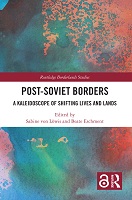Post-Soviet Borders
Proposal review
A Kaleidoscope of Shifting Lives and Landsr

Contributor(s)
von Löwis, Sabine (editor)
Eschment, Beate (editor)
Language
EnglishAbstract
This book investigates how borders in former Soviet Union territories have evolved and shifted in the thirty years since the end of the Cold War.The collapse of the Soviet Union in 1991 led to fifteen independent states and numerous de facto states; but this process of rebordering is not finished, and social, economic, infrastructural, cultural and political networks and spaces continue to develop. This book explores the intersection between these geopolitical shifts and the individual lived experience, drawing on cases from across border regions in the Caucasus, Central Asia and Eastern Europe. Throughout, the book introduces and frames the case studies with well-informed theoretical, conceptual and methodological overviews that situate them within border studies in general and post-Soviet border spaces in particular. Overall, the book demonstrates that like a kaleidoscope, the dynamic elements in these newly evolved border regions are similar yet strikingly different in their juxtapositions, with the appearance of new configurations often dependent on changing geopolitical constellations. This timely guide to the post-Soviet world thirty years after the Cold War will be of interest to researchers across border studies, politics, geography, social anthropology, history, Eastern European Studies, Central Asian Studies, and Caucasian Studies.
Keywords
Caucasus; Central Asia; Eastern Europe; geopolitical; rebordering; soviet unionDOI
10.4324/9781003169376ISBN
9780367770082, 9780367770105, 9781003169376Publisher
Taylor & FrancisPublisher website
https://taylorandfrancis.com/Publication date and place
2023Imprint
RoutledgeClassification
Development studies
